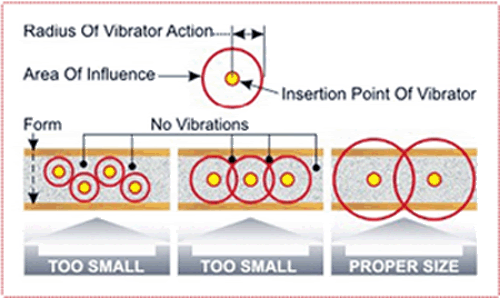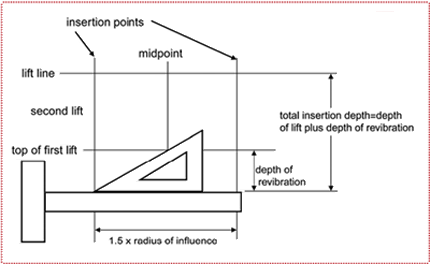• Do not use vibrators to move Concrete horizontally—this can result in separation of the aggregate from the paste (segregation). Vibrators can, however, he used to “melt” a pile of concrete that was placed by bucket or buggy.
• Keep lifts in walls and columns less than 20 inches thick or about the same as the length of the vibrator head.
• The critical questions for the vibrator operator are how far apart to insert the vibrator and how deep to penetrate into the preceding lift.
• Keep lifts in walls and columns less than 20 inches thick or about the same as the length of the vibrator head.
• The critical questions for the vibrator operator are how far apart to insert the vibrator and how deep to penetrate into the preceding lift.
• Vibrators should he sized and positioned to ensure that all concrete within the forms falls within the radius of influence (see Fig. 1). Use the largest vibrator that will fit between the reinforcement. The center-to- center distance between vibrator insertions should be 1 ½ times the radius of influence of the vibrator.
• Lifts should he placed while the preceding lift is still soft enough to penetrated by the vibrator. If that’s impossible, vibrate near the cold joint hut realize that a lift line will be visible.
• A graphical technique can help to determine how deep to penetrate into the preceding lift. Knowing that the vibration waves slope up at about a 30 degree angle from the tip, place a 30-60-90 triangle at the midpoint between the insertion points and measure the depth of revibration into the preceding lift and then the total insertion depth (see Fig. 2). Making sure that the boundary between lifts is vibrated will knit together the lifts and eliminate lift lines in the concrete.
• Insert the vibrator as quickly as possible to the proper depth into the previous lift. Typically it will sink under its own weight.
• Hold the vibrator at its maximum depth for S to 1S seconds. Withdraw it at 3 in./second for structural concrete or 2 in./second for architectural concrete (these are the withdrawal rates recommended by AC! 309). Slow withdrawal allows the vibrator to stay below the escaping air forcing it up and out of the concrete.
• Moving the vibrator up and down slightly closes the hole behind the vibrator.
• Make sure the vibrator head remains vertical—don’t force it in at an angle.
• Don’t force the vibrator into congested reinforced concrete because you can end up with a vibrator that is stuck in the reinforcement.
• Proper consolidation is often a judgment call—experienced operators can tell if they are getting good consolidation by the sound of the vibrator. • Lifts should he placed while the preceding lift is still soft enough to penetrated by the vibrator. If that’s impossible, vibrate near the cold joint hut realize that a lift line will be visible.
• A graphical technique can help to determine how deep to penetrate into the preceding lift. Knowing that the vibration waves slope up at about a 30 degree angle from the tip, place a 30-60-90 triangle at the midpoint between the insertion points and measure the depth of revibration into the preceding lift and then the total insertion depth (see Fig. 2). Making sure that the boundary between lifts is vibrated will knit together the lifts and eliminate lift lines in the concrete.
• Insert the vibrator as quickly as possible to the proper depth into the previous lift. Typically it will sink under its own weight.
• Hold the vibrator at its maximum depth for S to 1S seconds. Withdraw it at 3 in./second for structural concrete or 2 in./second for architectural concrete (these are the withdrawal rates recommended by AC! 309). Slow withdrawal allows the vibrator to stay below the escaping air forcing it up and out of the concrete.
• Moving the vibrator up and down slightly closes the hole behind the vibrator.
• Make sure the vibrator head remains vertical—don’t force it in at an angle.
• Don’t force the vibrator into congested reinforced concrete because you can end up with a vibrator that is stuck in the reinforcement.
• Despite all this, if you still have hug holes in the concrete surfaces (after stripping the forms), reduce the distance between insertion points by 20% to 30% below the standard 1½ times the radius of influence. If there are still some hug holes try spading near form surfaces
• Do not let the vibrator tip contact the form surfaces—this can damage the form panels. Rubber vibrator head tips can help reduce this potential damage.
• After the concrete surface has
stopped bleeding, revibration can he used to remove air pockets in the top lift. Don’t revibrate deeper than about 3 feet and also not with very stiff or harsh mixes.
• For exposed architectural concrete, experiment with vibration techniques to avoid color variations on the surface. For more information, read Guide to Cast-in-Place Architectural Concrete Practice, ACI 303 R-04.

FIGURE 1 Use the proper size of vibrator and keep vibrator insertions
at 1 ½ time the radius of influence

FIGURE 2 A graphical technique can help in determining howdeep the vibrator shoul penetrate into the preceding lift.
No comments:
Post a Comment